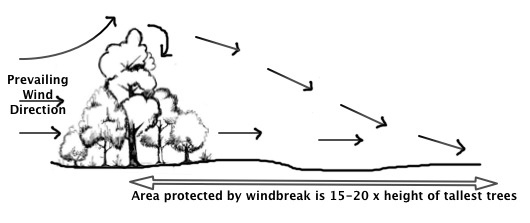How-to: Windbreaks
A windbreak is a strategic way of planting, usually made up of one or more rows of trees or shrubs planted in such a manner as to provide shelter from the wind. However, windbreaks can also be made from many items depending on your situation and what is possible. Some other ideas could be constructing a wall with rocks, building a fence, a wooden structure filled with branches and other organic materials, a caravan or a small building could even act as a windbreak!
Think multi-purpose!
In a permaculture system, a windbreak is never just a windbreak there can be many benefits! It may provide:
Firewood or timber for building
A place to forage fruits or other edibles
A habitat and food source for a range of local wildlife (Many small mammals, birds and insects and pollinators)
Preybird structures (in case of taller trees)
Forming Microclimates for plants, crops or for people
Zone of natural fertility from organic matter breaking down
A vine support structure
Protection from soil erosion
How to create your windbreak with plants?
Windbreaks should consist of a minimum of 2 rows. Rows should be space between 2-4m apart. The tallest trees should be in either the centre or windward row and be planted 3-6m apart. Smaller trees and larger shrubs should be planted on the outer rows, spaced 2-4m apart. The smallest shrubs should be planted on the outer edges 1-2m apart. A windbreak hedge should always be positioned at a right angle to the prevailing wind direction on site. Hedges are placed not with reference to the wind, but with reference to property boundaries. If your primary goal is wind breaking, try not to fall prey to this mistake.
Two requirements:
ratio height - protected area:
The area protected by a windbreak is generally around 20 times the height of the tallest trees. So if you want the protected area to be around 40 meters, your hedge should be around 2 meters high.
2. ratio height - length:
When positioning a new windbreak hedge, it is also important to consider the length of the hedge in relation to its height. As a general rule of thumb, the ratio of height to length should be around 1:10, so a windbreak hedge of 2m in height should ideally be no less than 20m long. While this is not always practicable, following this ratio will help to reduce turbulence around the ends of the windbreak.
How to create your “Compost windbreak” ?
At Pomar dos Sabores, we also created a windbreak made of two rows of tall vertical wooden posts (between 3 to 4 meters) and on one side a wire mesh. We filled this “tunnel” with a variety of organic materials (branches, banana stems, leaves). The windbreak effect is achieved because the piled organic materials still let some wind to pass and therefore we can avoid turbulences. The wire mesh is used as a structure for vines (Passiflora edulis, Sechium edule) which will benefit from the shade and from the composting process.
Good Windbreak Fruit Trees or Shrubs
Below you can find a selection of trees of different heights whose foliage is evergreen, dense and which are quite wind resistant. They all offer the added value of being fruit trees!
— small to medium:
CHRYSOPOGON ZIZANIOIDES, ACCA SELLOWIANA, ARBUTUS UNEDO, CALLISTEMON VIMINALIS, ELAEAGNUS UMBELLATA, EUGENIA UNIFLORA.
— taller edible plants:
INGA EDULIS, PERSEA AMERICANA, PHYLLOSTACHYS BISSETTII, PHYLLOSTACHYS VIRIDIS, PHYLLOSTACHYS AUREA, PHYLLOSTACHYS EDULIS, SACCHARUM OFFICINARUM, SYZYGIUM AUSTRALE, SYZYGIUM PANICULATUM.
Underneath, you can find detailed information about all the planted windbreaks in our database.
Small to medium edible fruit trees suitable as hedge windbreak:
Tall edible fruit trees suitable as high windbreak:
This article was compiled by Miguel COTTON & Jackson KNIGHTS. If you have any questions or suggestions, do not hesitate to contact us. miguel@orchardofflavours.com









